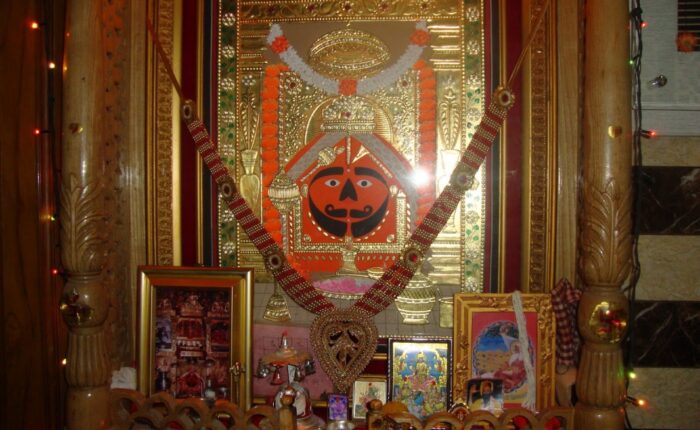Shri Hanumanji in Ramanand Sampradaya

Ramanand (C. 1400 CE to 1476 CE) was a leading saint of the Bhakti Movement in the category of liberal saints like Kabir and Guru Nanak. He was against caste distinctions and preached from Varanasi and Agra about his devotion to Ram, Sita and Hanuman. He was the main saint for spreading the Ram cult in northern India. His followers became Ramanandis and constituted the Ramanand Sampradaya for whom Hanuman is specially placed.
Bhagavat Purana talks about nine types (Nav-Vidhi or Navadha Bhakti) of devotion to God.
“Shravanam Kirtanam Vishnoh
Smarnam Paad Sevanam
Archanam Vandanam Dasyam
Sakhya Atmanivedanam”
- Srimad Bhagavad 7.5.23
Shravan (listening), Kirtan (name singing), Smaran (name remembrance), Paad Sevan (feet worship), Vandana (salutation), Dasya (servitude), Sakhya (friendliness) and Atma-Nivedan (Self-submission) are the nine types of Bhakti (devotion). Hanuman is believed to be the Acharya of the dasya bhava by people at large. However, in Ramanandi Sampradaya he is regarded as the daily attendant of Ram whose permission is a must for an audience with Ram.
In Ramanandi Sampradaya he is invited for puja with other inseparable associates.
“Agachcha Janakinatha
Janakya Sah Raghava
Grihan Mam Pujam Cha
Vayuputradi Viryutah”
Every offering to Ram is received by Hanuman which gets passed ahead to Ram and therefore any independent offering directly to Ram is not permissible in Ramanandi Sampradaya. They also believe that Hanuman is immortal and does not take birth. He incarnates through some medium to perform the works of Ram. In the Hindu belief system, eight mythological characters are regarded as immortal.
“Asvatthama Balir Vyaso
Hanumanshcha Vibhishanah
Kripah Parshuramascha
Saptainte Chirjivinah
……………….. Markandeyam Yathashtamam”
- Anand Ramayan
(Hindu scriptures consider Ashvatthama, Bali Raja, Ved Vyasa, Hanuman, Vibhishan, Kripacharya, Parshuram and Markendya immortal.)
In Ramanandi Sampradaya Sri Hanuman is the main Acharya (Guru) for Ram mantra. Ramopanishad and Ram Rahasyopanished are two Upanishads in which the Guru of Ram Mantra is Hanuman and he performs the function of Acharya. Hanuman cannot be separated from Ram. Therefore, “Aum Ramaya Namah” has to be followed by “Aum Hanumate Namah” in the Ramanandi puja system. The Ram Gayatri Mantra is closely followed by the Hanuman Gayatri Mantra as given below.
Ram Gayatri:
“Dasharathaya Vidmahe Sitaballabhaya
Dhimahi Tanno Ramah Prachodayat”
Hanuman Gayatri:
“Anjaneyaya Vidmahe Mahabalaya
Dhimahi Tanno Hanuman Prachodayat”
In other sects, the worship of Ram can be done independently but it is not possible in the Ramanandi belief system. Sri Hanumanji is also revered for popularising the significance of the Ram Mantra. In “Siddhantadipak” of the Sampradaya it has been stated that:
“Marutim Veera Vajrangam
Bhakta Rakshan Dikshhitam
Hanumanta Sada Vande
Ram Mantra Pracharakam”
Hanuman is not only the Acharya of Ram Bhakti he is also the completely egoless attendant of Ram. He also acts as the disciple of Ram in Muktikopanishads in which the names of 108 Upanishads have been given. Hanuman is not in the habit of taking any credit for very difficult tasks assigned to him and for completing them. He simply ascribes his accomplishments to Ram Kripa and the blessings of Ram.
There is a system of Vishnu Mahayagya, Rudra Mahayagya and other Gods in Hinduism. Similarly, there is a system of Hanuman Mahayagya in the Ramanandi Sampradaya. Images of Hanuman statues are installed in several forms in the Ramanandi system.
- Bala Hanuman (Balaji) is the most popular form of child Hanuman and several such Balaji temples are found in India. Some Balaji temples of Rajasthan are famous for their religious importance.
- Manokamna Hanuman temples have been built by many devotees across the country. These temples are visited by those who want their wishes fulfilled.
- Panchmukhi Hanuman temples are important for elaborate Hanuman Puja in which Tantric systems are used. Such Anushthan are on a large scale.
- Sankat-Mochan Hanuman mandirs are extremely popular. Hanumanji is considered the destroyer of obstacles like Ganapati. He also protects from ghosts and evil spirits. The Sankat Mochan temple at Varanasi is a “Siddha Sthan” for the worship of Hanuman.
Hanuman faced obstacles during Sita search operations created by Triguni Maya (Satoguni Maya represented by Surasa, Rajoguni Maya represented by Lankini and Tamoguni Maya represented by Sinhika). He outwitted Sursa and received her blessings for victory. He used his fists to make Lankini unconscious but she also blessed him for victory after regaining consciousness. Sinhika who was stubborn was killed by his kick. He faced obstacles but these could not deter him from completing his work.
References:
- Kalyan Hanuman Ank published by Geeta Press, Gorakhpur.
I am a Vedic astrologer by profession. I have done Jyotish Acharya from Bhartiya Vidya Bhawan. I am devoted to my Sadguru Shri Sai Nath of Shirdi. I am also interested in spirituality. I love to guide people.